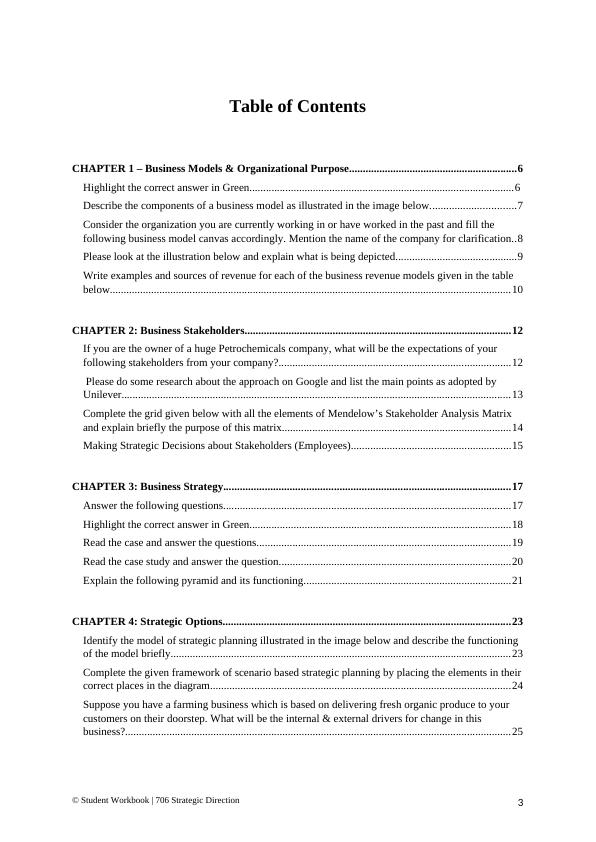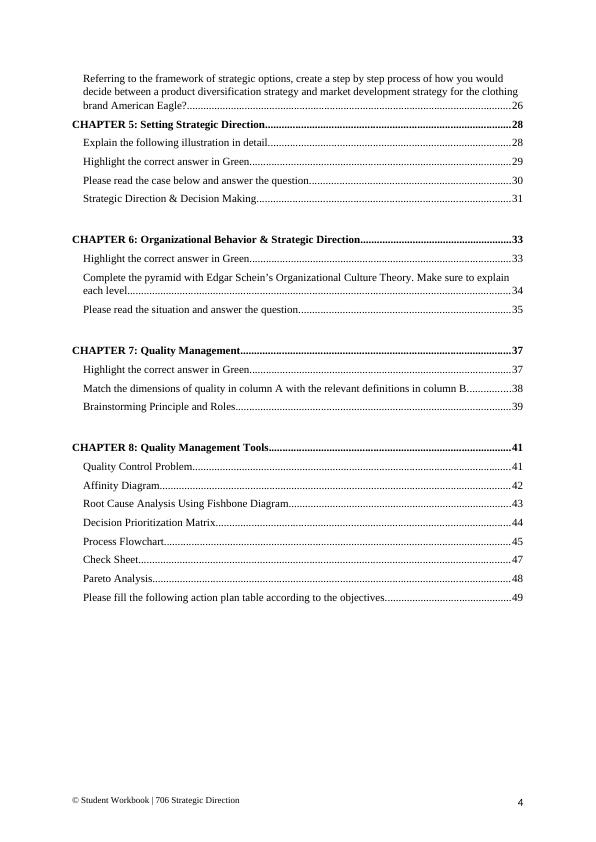Strategic Direction Workbook for 706 Course
58 Pages8047 Words233 Views
Added on 2023-06-13
About This Document
This workbook is for the 706 Strategic Direction course and includes chapters on business models, stakeholders, business strategy, strategic options, setting strategic direction, organizational behavior, and quality management. It contains instructions, questions, and case studies for each chapter. The workbook must be done individually and submitted online through EGSM LMS. The submission deadline is 4 weeks from the class date, and it weighs 15% of the total assessment. The workbook covers various topics such as customer value creation, stakeholder analysis, strategic planning, quality management tools, and more.
Strategic Direction Workbook for 706 Course
Added on 2023-06-13
ShareRelated Documents
Strategic Direction
Workbook
GENERAL INSTRUCTIONS
© Student Workbook | 706 Strategic Direction 1
Workbook
GENERAL INSTRUCTIONS
© Student Workbook | 706 Strategic Direction 1

This workbook must be done individually.
This workbook must be submitted online through EGSM LMS
PRESENTATION OF WORKBOOK
You must include a title page that lists your name, Student ID and the unit number and
title.
Number all pages sequentially.
Any published material you refer to must be properly referenced (Harvard Referencing)
and included in a reference list at the end of your workbook.
WORKBOOK SUBMISSION DEADLINE
Due Date: Thursday, 4 weeks from the class date
Weighing: 15% of the total assessment
LATE WORKBOOK SUBMISSION POLICY
After your enrolment date, you will have 30 days to complete and submit your Workbook.
The assessment submission option will only be available on EGSM LMS Portal for 30 days.
If you have not submitted your assessment within 30 days, you will be required to send an
email to mentioning the reason of non-submission and late penalty may apply.
NOTE: The first page of each workbook must include the following declaration:
I certify that this workbook is my own work, based on my personal study and/or research,
and that I have acknowledged all materials and sources used in the preparation of this
workbook whether they be books, articles, reports, lecture notes, any other kind of document,
electronic or personal communication.
I also certify that this workbook has not previously been submitted for assessment in any
other course or at any other time in this Course, unless by negotiation, and that I have not
copied in part or whole or otherwise plagiarised the work of other students and/or persons. I
have read the policy on plagiarism and understand its implications.
Workbook that do not include the above declaration will not be marked.
© Student Workbook | 706 Strategic Direction 2
This workbook must be submitted online through EGSM LMS
PRESENTATION OF WORKBOOK
You must include a title page that lists your name, Student ID and the unit number and
title.
Number all pages sequentially.
Any published material you refer to must be properly referenced (Harvard Referencing)
and included in a reference list at the end of your workbook.
WORKBOOK SUBMISSION DEADLINE
Due Date: Thursday, 4 weeks from the class date
Weighing: 15% of the total assessment
LATE WORKBOOK SUBMISSION POLICY
After your enrolment date, you will have 30 days to complete and submit your Workbook.
The assessment submission option will only be available on EGSM LMS Portal for 30 days.
If you have not submitted your assessment within 30 days, you will be required to send an
email to mentioning the reason of non-submission and late penalty may apply.
NOTE: The first page of each workbook must include the following declaration:
I certify that this workbook is my own work, based on my personal study and/or research,
and that I have acknowledged all materials and sources used in the preparation of this
workbook whether they be books, articles, reports, lecture notes, any other kind of document,
electronic or personal communication.
I also certify that this workbook has not previously been submitted for assessment in any
other course or at any other time in this Course, unless by negotiation, and that I have not
copied in part or whole or otherwise plagiarised the work of other students and/or persons. I
have read the policy on plagiarism and understand its implications.
Workbook that do not include the above declaration will not be marked.
© Student Workbook | 706 Strategic Direction 2

Table of Contents
CHAPTER 1 – Business Models & Organizational Purpose.............................................................6
Highlight the correct answer in Green................................................................................................6
Describe the components of a business model as illustrated in the image below...............................7
Consider the organization you are currently working in or have worked in the past and fill the
following business model canvas accordingly. Mention the name of the company for clarification..8
Please look at the illustration below and explain what is being depicted............................................9
Write examples and sources of revenue for each of the business revenue models given in the table
below..................................................................................................................................................10
CHAPTER 2: Business Stakeholders.................................................................................................12
If you are the owner of a huge Petrochemicals company, what will be the expectations of your
following stakeholders from your company?....................................................................................12
Please do some research about the approach on Google and list the main points as adopted by
Unilever.............................................................................................................................................13
Complete the grid given below with all the elements of Mendelow’s Stakeholder Analysis Matrix
and explain briefly the purpose of this matrix...................................................................................14
Making Strategic Decisions about Stakeholders (Employees)..........................................................15
CHAPTER 3: Business Strategy........................................................................................................17
Answer the following questions........................................................................................................17
Highlight the correct answer in Green...............................................................................................18
Read the case and answer the questions............................................................................................19
Read the case study and answer the question....................................................................................20
Explain the following pyramid and its functioning...........................................................................21
CHAPTER 4: Strategic Options.........................................................................................................23
Identify the model of strategic planning illustrated in the image below and describe the functioning
of the model briefly............................................................................................................................23
Complete the given framework of scenario based strategic planning by placing the elements in their
correct places in the diagram.............................................................................................................24
Suppose you have a farming business which is based on delivering fresh organic produce to your
customers on their doorstep. What will be the internal & external drivers for change in this
business?............................................................................................................................................25
© Student Workbook | 706 Strategic Direction 3
CHAPTER 1 – Business Models & Organizational Purpose.............................................................6
Highlight the correct answer in Green................................................................................................6
Describe the components of a business model as illustrated in the image below...............................7
Consider the organization you are currently working in or have worked in the past and fill the
following business model canvas accordingly. Mention the name of the company for clarification..8
Please look at the illustration below and explain what is being depicted............................................9
Write examples and sources of revenue for each of the business revenue models given in the table
below..................................................................................................................................................10
CHAPTER 2: Business Stakeholders.................................................................................................12
If you are the owner of a huge Petrochemicals company, what will be the expectations of your
following stakeholders from your company?....................................................................................12
Please do some research about the approach on Google and list the main points as adopted by
Unilever.............................................................................................................................................13
Complete the grid given below with all the elements of Mendelow’s Stakeholder Analysis Matrix
and explain briefly the purpose of this matrix...................................................................................14
Making Strategic Decisions about Stakeholders (Employees)..........................................................15
CHAPTER 3: Business Strategy........................................................................................................17
Answer the following questions........................................................................................................17
Highlight the correct answer in Green...............................................................................................18
Read the case and answer the questions............................................................................................19
Read the case study and answer the question....................................................................................20
Explain the following pyramid and its functioning...........................................................................21
CHAPTER 4: Strategic Options.........................................................................................................23
Identify the model of strategic planning illustrated in the image below and describe the functioning
of the model briefly............................................................................................................................23
Complete the given framework of scenario based strategic planning by placing the elements in their
correct places in the diagram.............................................................................................................24
Suppose you have a farming business which is based on delivering fresh organic produce to your
customers on their doorstep. What will be the internal & external drivers for change in this
business?............................................................................................................................................25
© Student Workbook | 706 Strategic Direction 3

Referring to the framework of strategic options, create a step by step process of how you would
decide between a product diversification strategy and market development strategy for the clothing
brand American Eagle?......................................................................................................................26
CHAPTER 5: Setting Strategic Direction.........................................................................................28
Explain the following illustration in detail........................................................................................28
Highlight the correct answer in Green...............................................................................................29
Please read the case below and answer the question.........................................................................30
Strategic Direction & Decision Making............................................................................................31
CHAPTER 6: Organizational Behavior & Strategic Direction.......................................................33
Highlight the correct answer in Green...............................................................................................33
Complete the pyramid with Edgar Schein’s Organizational Culture Theory. Make sure to explain
each level...........................................................................................................................................34
Please read the situation and answer the question.............................................................................35
CHAPTER 7: Quality Management..................................................................................................37
Highlight the correct answer in Green...............................................................................................37
Match the dimensions of quality in column A with the relevant definitions in column B................38
Brainstorming Principle and Roles....................................................................................................39
CHAPTER 8: Quality Management Tools........................................................................................41
Quality Control Problem....................................................................................................................41
Affinity Diagram................................................................................................................................42
Root Cause Analysis Using Fishbone Diagram.................................................................................43
Decision Prioritization Matrix...........................................................................................................44
Process Flowchart..............................................................................................................................45
Check Sheet.......................................................................................................................................47
Pareto Analysis..................................................................................................................................48
Please fill the following action plan table according to the objectives..............................................49
© Student Workbook | 706 Strategic Direction 4
decide between a product diversification strategy and market development strategy for the clothing
brand American Eagle?......................................................................................................................26
CHAPTER 5: Setting Strategic Direction.........................................................................................28
Explain the following illustration in detail........................................................................................28
Highlight the correct answer in Green...............................................................................................29
Please read the case below and answer the question.........................................................................30
Strategic Direction & Decision Making............................................................................................31
CHAPTER 6: Organizational Behavior & Strategic Direction.......................................................33
Highlight the correct answer in Green...............................................................................................33
Complete the pyramid with Edgar Schein’s Organizational Culture Theory. Make sure to explain
each level...........................................................................................................................................34
Please read the situation and answer the question.............................................................................35
CHAPTER 7: Quality Management..................................................................................................37
Highlight the correct answer in Green...............................................................................................37
Match the dimensions of quality in column A with the relevant definitions in column B................38
Brainstorming Principle and Roles....................................................................................................39
CHAPTER 8: Quality Management Tools........................................................................................41
Quality Control Problem....................................................................................................................41
Affinity Diagram................................................................................................................................42
Root Cause Analysis Using Fishbone Diagram.................................................................................43
Decision Prioritization Matrix...........................................................................................................44
Process Flowchart..............................................................................................................................45
Check Sheet.......................................................................................................................................47
Pareto Analysis..................................................................................................................................48
Please fill the following action plan table according to the objectives..............................................49
© Student Workbook | 706 Strategic Direction 4

CHAPTER 1
Business Models &
Organizational Purpose
© Student Workbook | 706 Strategic Direction 5
Business Models &
Organizational Purpose
© Student Workbook | 706 Strategic Direction 5

CHAPTER 1 – Business Models & Organizational Purpose
Highlight the correct answer in Green.
(1 mark each)
1. What are the key characteristics of an appropriate business model?
A. Nice-looking visuals in the business model canvas
B. It is profitable, implementable, and scalable
C. Minimum 30% revenue after the second year
D. All of the above
2. Which of these questions are not necessarily answered by a business model?
A. What actionable metric to define?
B. Which qualitative metrics to be used?
C. How is value created, delivered, and captured?
D. How can quantitative metrics be applied?
3. Which of these are not described by a business model?
A. Flexibility
B. Feasibility
C. Desirability
D. Viability
4. Which of the following is not a type of business models?
A. Distributor
B. Retailer
C. Allocator
D. Manufacturer
5. Which of the following is the best definition of a business model?
A. A plan that is based on legislative requirements for a business
B. A company’s plan to generate revenue through operations, with the goal of making
a profit
C. A company’s plan to become the sole operator within an industry
D. The hierarchy of a company starting with the CEO
© Student Workbook | 706 Strategic Direction 6
Highlight the correct answer in Green.
(1 mark each)
1. What are the key characteristics of an appropriate business model?
A. Nice-looking visuals in the business model canvas
B. It is profitable, implementable, and scalable
C. Minimum 30% revenue after the second year
D. All of the above
2. Which of these questions are not necessarily answered by a business model?
A. What actionable metric to define?
B. Which qualitative metrics to be used?
C. How is value created, delivered, and captured?
D. How can quantitative metrics be applied?
3. Which of these are not described by a business model?
A. Flexibility
B. Feasibility
C. Desirability
D. Viability
4. Which of the following is not a type of business models?
A. Distributor
B. Retailer
C. Allocator
D. Manufacturer
5. Which of the following is the best definition of a business model?
A. A plan that is based on legislative requirements for a business
B. A company’s plan to generate revenue through operations, with the goal of making
a profit
C. A company’s plan to become the sole operator within an industry
D. The hierarchy of a company starting with the CEO
© Student Workbook | 706 Strategic Direction 6

CHAPTER 1 - Business Models & Organizational Purpose
Describe the components of a business model as illustrated in the image below.
(5 marks)
Please type your answer below
Customer Value Creation : With your one-of-a-kind value offer, you provide value to your
consumers (UVP). To design an efficient UVP, you must first have a thorough understanding of
your clients and their concerns. You'll be in the best position to build a solution from which your
UVP may be derived.
Customer Value Delivery: Customers find your solution through your channels, and you give
value to them through it. Your cost structure box contains the cost of value delivery. When using
a lean strategy, the focus is on delivering client value as quickly as possible, because showing
value creation is the riskiest assumption to make at the start of any project. You won't be able to
collect any value if you don't provide value for your consumers (aka get paid).
This is why starting with a minimal viable product (MVP) rather than your completely realised
vision of your final solution is a good idea.
Customer Value Capture: Your income streams allow you to recoup value from your
consumers. It's critical to mention both your income streams and particular pricing for business
modelling reasons. Ballparks are fine if you aren't sure about particular price yet.
Many entrepreneurs make the mistake of imposing a tiny margin over what it costs them to offer
value when pricing their products against their solutions. This is a mistake since your clients are
more concerned with the value they get from your product than with your costs. You not only
make it simpler for consumers to buy from you by anchoring your pricing strategy on customer
value generation, but you can also charge more for your products with a value-based vs a cost-
based pricing approach.
© Student Workbook | 706 Strategic Direction 7
Describe the components of a business model as illustrated in the image below.
(5 marks)
Please type your answer below
Customer Value Creation : With your one-of-a-kind value offer, you provide value to your
consumers (UVP). To design an efficient UVP, you must first have a thorough understanding of
your clients and their concerns. You'll be in the best position to build a solution from which your
UVP may be derived.
Customer Value Delivery: Customers find your solution through your channels, and you give
value to them through it. Your cost structure box contains the cost of value delivery. When using
a lean strategy, the focus is on delivering client value as quickly as possible, because showing
value creation is the riskiest assumption to make at the start of any project. You won't be able to
collect any value if you don't provide value for your consumers (aka get paid).
This is why starting with a minimal viable product (MVP) rather than your completely realised
vision of your final solution is a good idea.
Customer Value Capture: Your income streams allow you to recoup value from your
consumers. It's critical to mention both your income streams and particular pricing for business
modelling reasons. Ballparks are fine if you aren't sure about particular price yet.
Many entrepreneurs make the mistake of imposing a tiny margin over what it costs them to offer
value when pricing their products against their solutions. This is a mistake since your clients are
more concerned with the value they get from your product than with your costs. You not only
make it simpler for consumers to buy from you by anchoring your pricing strategy on customer
value generation, but you can also charge more for your products with a value-based vs a cost-
based pricing approach.
© Student Workbook | 706 Strategic Direction 7

© Student Workbook | 706 Strategic Direction 8

End of preview
Want to access all the pages? Upload your documents or become a member.
Related Documents
An Overview of Turnitin Toolslg...
|7
|2412
|15
Recruit, select, and induct written questionslg...
|31
|7217
|171
BSBMGT517 Manage Operational Plan Assignmentlg...
|26
|7315
|103
BSBLDR502 Lead and Manage Effective Workplace Relationshipslg...
|32
|6862
|81
BSBADM502 - Manage meetingslg...
|30
|8212
|436
Safety Culture and Compliance - Assessment Workbook 1lg...
|5
|928
|55
